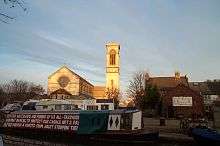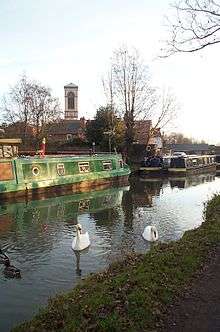St Barnabas Church, Oxford
St Barnabas Church is a Church of England parish church in Jericho, central Oxford, England, located close to the Oxford Canal.[2][3]
| St Barnabas Church, Oxford | |
|---|---|
View of St Barnabas Church and its campanile | |
 St Barnabas Church, Oxford | |
| 51.7578°N 1.2697°W | |
| Location | St Barnabas Street, Jericho, Oxford, Oxfordshire, OX2 6BG |
| Country | England |
| Denomination | Church of England |
| Churchmanship | Traditional Catholic |
| Website | Parish website |
| History | |
| Status | Active |
| Founder(s) | Thomas Combe and Martha Combe[1] |
| Dedication | St Barnabas |
| Consecrated | 19 October 1869 |
| Architecture | |
| Functional status | Parish church |
| Architect(s) | Sir Arthur Blomfield |
| Architectural type | Victorian, Romanesque, Italianate |
| Specifications | |
| Bells | tubular |
| Administration | |
| Parish | Oxford St. Barnabas and St. Paul with St Thomas the Martyr |
| Deanery | Oxford Deanery |
| Archdeaconry | Archdeaconry of Oxford |
| Episcopal area | Oxford Episcopal Area |
| Diocese | Diocese of Oxford |
| Clergy | |
| Vicar(s) | Fr Christopher Woods |
| Assistant priest(s) | Fr Kenneth Jeffery (Honorary) |
| Deacon(s) | The Revd Canon Prof Sue Gillingham
The Revd James Mosher |
| Laity | |
| Reader(s) | Jenny Pittaway Maggie Ellis |
| Director of music | Dr Tom Edwards (Assistant director Dr Philip Burnett) |
| Organist(s) | Mr Martin Payne |
| Organ scholar | Saralynn Culpepper |
| Churchwarden(s) | Claire Herbertson and Hanneke Wilson |
History
St Barnabas, like many similar churches in the expanding towns and cities of Victorian England, was built to minister to the spiritual and practical needs of the poor and labouring classes. The parish was formed from that of St Paul, Oxford, in 1869; St Paul's was in turn formed from parts of the parishes of St Thomas and St Giles. The church was founded by Thomas Combe (1796–1872), Superintendent of the Oxford University Press close to the church, and his wife Martha (1806–1893), now commemorated by a blue plaque installed by the Oxfordshire Blue Plaques Board.[1] They were supporters of the Oxford Movement (or Tractarian movement). The first Parish Priest was Fr Montague Noel, SSC.
The architect was Sir Arthur Blomfield, a son of the Bishop of London, who had previously designed the chapel for the Radcliffe Infirmary. The architectural style is that of a Romanesque basilica, possibly modelled on San Clemente in Rome. St Barnabas has a distinctive square tower, in the form of an Italianate campanile, that is visible from the surrounding area. The church was built on land donated by George Ward, local land owner and member of the influential Ward family (named as the donor in the land conveyance etc. in the Oxford Diocesan Archives). George's brother William Ward was Mayor of Oxford on two occasions, 1851/2 and 1861/2.[4] It was consecrated in 1869 by Bishop Wilberforce of Oxford and the campanile was completed in 1872. The pulpit was added in 1887 by Heaton, Butler and Bayne with the panels painted by Charles Floyce.[5]
It has a ring of ten, distinctive, tubular bells, and the hours and quarters are sounded on them. St Barnabas features in a wide range of literature, from Thomas Hardy through to P. D. James. The poet John Betjeman wrote a poem about the church.[3][6] A short guide to the building and its story is available from the church, as is the Emma Bridgewater 'Jericho' mug, commissioned specially for St Barnabas.
Present day
The church maintains the Anglo-Catholic tradition of its foundation and is open daily for worship. A parish magazine, Jericho Matters, is produced quarterly and distributed to all of the households and businesses in Jericho. The church hosts many events throughout the year, such as concerts, lectures and exhibitions.
In September 2015 the parish was united with the neighbouring parish of St Thomas the Martyr, to form the new parish of St Barnabas and St Paul, with St Thomas the Martyr, Oxford. St Barnabas is the parish church and St Thomas is the chapel of ease. The first vicar of the new parish was Fr Jonathan Beswick, SSC.[7]
Gallery

 St Barnabas Church from the Oxford Canal in Jericho.
St Barnabas Church from the Oxford Canal in Jericho. View of the campanile from the northwest across the Oxford Canal.
View of the campanile from the northwest across the Oxford Canal.
References
- Warr, Elizabeth Jean (2011). The Oxford Plaque Guide. Stroud, Gloucestershire: The History Press. pp. 39–41. ISBN 978-0-7524-5687-4.
- Hibbert, Christopher, ed. (1988). "St Barnabas, Church of". The Encyclopaedia of Oxford. Macmillan. p. 378–379. ISBN 0-333-39917-X.
- "Oxford: St Barnabas, Oxford". The Church of England. 2012. Retrieved 11 July 2016.
- "William Ward: Mayor of Oxford 1851/2 and 1861/2". Oxford History: Mayors & Lord Mayors. 4 November 2012. Retrieved 11 July 2016.
- "New Pulpit". Oxford Journal. 6 August 1887. p. 5.
- "St Barnabas Church". Jericho Living Heritage Trust. 3 November 2009. Retrieved 11 July 2016.
- "Contact details". St Barnabas Church.
Further reading
- Bassett, Arthur Tilney (1919) S. Barnabas', Oxford: a record of fifty years. London: A. R. Mowbray
- Sherwood, Jennifer; Pevsner, Nikolaus (1974). Oxfordshire. The Buildings of England. Harmondsworth: Penguin Books. pp. 289–291. ISBN 0-14-071045-0.CS1 maint: ref=harv (link)
External links
| Wikimedia Commons has media related to St Barnabas' Church, Oxford. |